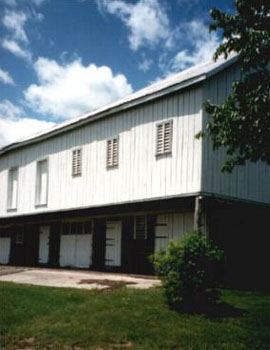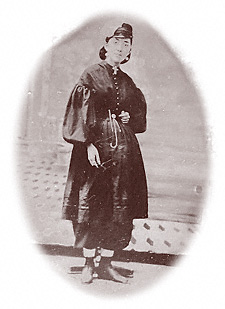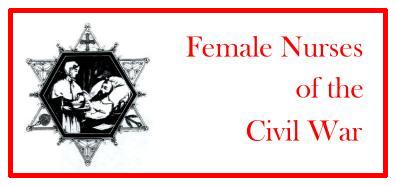Amanda Colburn Farnham
Amanda Colburn Farnham

(Image reprinted from the 1895 edition of Our Army Nurses)
"Mrs. Farnham, the dress you wear is abominable, a most abominable dress, and I do not wish any of my nurses to dress in that manner; but you came highly recommended, and I have long known of your work, but I didn't know you wore such a dress. However, you can wear it if you choose."
(Dorothea Dix, 1864)
Amanda M. Colburn was born on November 12, 1833 in the town of West Glover, Vermont. Being the only daughter of a farmer, she quickly became accostumed to hard out door work that required plenty of physical strength.
At about 23 years of age, Amanda married a Mr. Farnham (according to Mary Gardner Holland's book, published in 1895). However, no records exist in Vermont verifying this marriage, nor the birth of a son, who she supposedly left under the care of her parents in 1861.
In June of 1861, at the age of 27, Amanda followed her brother who had enlisted in the 3rd Vermont Volunteer Infantry. She was appointed as Hospital Matron for the regiment, and even paid as such for the first six months of her service. An order from the War Department, however, stated that: "no Hospital Matrons should be paid for further service in the field."
Amanda continued to volunteer her services regardless of the order. One observer noted of her:
"Day or night it made no difference, she always responded to the call, and would stay until the crisis passed, or death had relieved the patient of his suffering. But it was to the boys, like her brother, that her heart went out with greatest sympathy. Writing letters for such was a daily practice, and when there was no hope she would record the dying request, and take care of some keepsake to be sent to friends at home."
In 1862, Amanda wrote that she followed the Vermont Brigade during the Peninsula Campaign, helping to care for the sick and wounded. She was also present during the Seven Days Battle (June 25 - July 1), working tirelessly in the field hospitals and on the field. She wrote that throughout the Campaign she "marched on foot with the soldiers."
In August of the same year, Amanda returned North again, visiting her home and also caring for the sick and wounded in hospitals near Washington, D.C. In September she received an order from Secretary Stanton to rejoin the army and bring an ambulance with her. She arrived while the Battle of Antietam was in progress, and it was at this battle that Amanda performed "her first and only surgical operation." She extracted a ball from below the shoulder blade of a soldier who had been struck.
Amanda was present again at the Battle of Fredericksburg in December of 1862. One hospital steward of the 4th Vermont wrote: "Mrs. Farnham, who was stationed at the Burnard House, worked with the wounded without rest until getting back to the old camps at White Oak Church," where she was appointed Matron.
In May of 1863, Amanda was seen at the Battle of Chancellorsville. Accounts mention that a few days before this battle, several men had intrusted her with an unusually high amount of money and other valuables for safe-keeping. She stored these items in a hand bag, and at night she hid the bag under her blankets in her tent. At some point during the night, she was awakened by an intruder who attempted to get inside her tent, most likely to steal the money she was hiding. Finding her revolver, Amanda fired at the intruder who then quickly fled from the scene. The following morning, she heard that one of the new recruits was wounded during the night by "accidental discharge of a pistol in the hands of a chum." Amanda did not desire to have the case investigated.
Amanda was present during the Gettysburg Campaign, accompanying the 6th Corps on its march from the Rappahannock to Gettysburg. One soldier commented:
"The last day they went thirty-four miles over a stone road, and under a burning sun . . . Mrs. Farnham went with them, and most of the way on foot, giving up the spare room on her wagon to worn-out soldiers . . . Thus many more were able to keep along than would have been without such help. Again, when she found a poor fellow with blistered feet, she gave him a pair of new socks to take the place of the holes, all that was left of his own."
Amanda arrived in Gettysburg on the eve of the second day of battle. She immediately went to work, aiding the wounded of the 3rd Corps without rest.

The field hospital Amanda supposedly worked at following the battle of Gettysburg
(Courtesy of Britta Arendt, the Webmaster)
From Gettysburg, Amanda followed the Vermont Brigade to Funkstown, Maryland, where they were engaged in yet another battle. Amanda returned home to Vermont with the remains of those killed, but she later rejoined the Brigade before the end of July. She stayed with them through the Bristoe Campaign (October - November 1863) as well as the Mine Run Campaign (November).
By the Spring of 1864, General Grant ordered all women associated with the Army of the Potomac to leave the front. Although the officers of the 6th Corps heavily petitioned to have Amanda stay, the request was refused, and she was forced to return to Washington, D.C. However, at this time, she was summoned by Dorothea Dix. Upon their meeting, Miss Dix realized for the first time that Amanda wore the rational dress (also known as the "Bloomer Costume"). One of her outfits was described as "full pants buttoning over the tops of her boots, skirts falling a little below the knee, and a jacket with tight sleeves." Amanda had been known for wearing outfits similar to this style throughout her service as a nurse, as it allowed her to work more efficiently.

This nurse is unidentified, but she bares a strong resemblance to Amanda Farnham and wears a rational dress as well.
(Courtesy of Our Army Nurses)
Despite Miss Dix's dismay, Amanda was encouraged to report directly to Surgeon Dalton of the 6th Corps at Fredericksburg, Virginia, where the wounded were being taken to from the battlefields of the Wilderness and Spotsylvania. Amanda remained at the field hospital until the end of June, when she was summoned to White House on the Pamunkey. It was here that Amanda first established a plan to wash all clothing and bedding used by the wounded so that they could be used again. Previously these items were burned, but with the lack of new supplies coming in, it became a necessity to save such items.
Upon the establishment of hospitals at City Point, Amanda was appointed by Miss Dix to "take entire charge of this new department at the 6th Corps Hospital."
Sometime during the War Amanda fell in love with Marshall P. Felch, a hospital steward of the 4th Vermont, Co. H. They were married on December 16, 1865, after both had completed their hospital services. After their marriage, the couple decided to move westward to St. Joseph, Missouri. In October of 1866, they made their final move to a town near Denver, Colorado. The couple had at least four children, although two of them died during childhood.
Despite Mr. Felch's heart problems and partial paralysis resulting from his service during the War, he became an ammature paleontologist, uncovering a Stegosaurus and Alosaurus in Garden City, Colorado. Amanda was known to provide dinner for people visiting the site.
Amanda filed for pension in 1888 for her services as a nurse during the Civil War, and in March of 1891 it was passed as a private claim by Congress for a total of $12.00.
Amanda died at St. Luke's Hospital in Denver on December 31, 1893 and was buried in Greenwood Pioneer Cemetery near Canon City, Colorado.
Back to
Copyright 2002 by Britta Arendt



